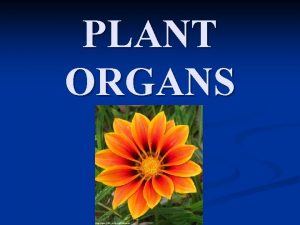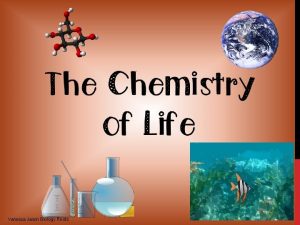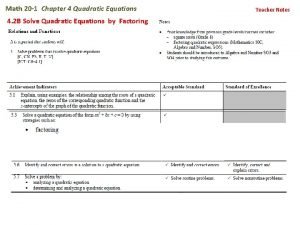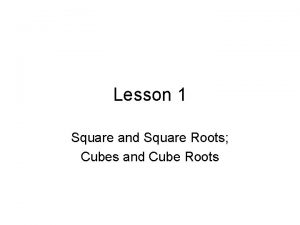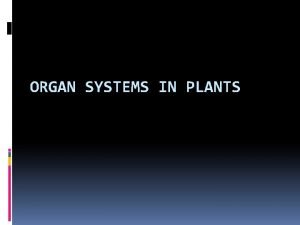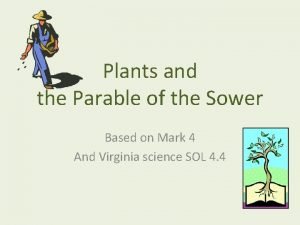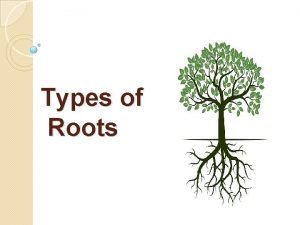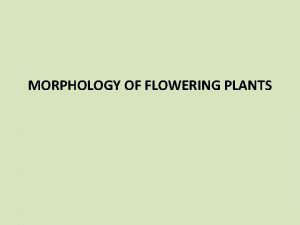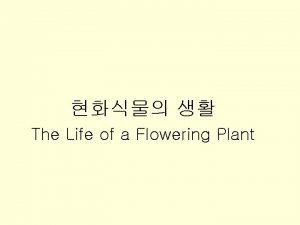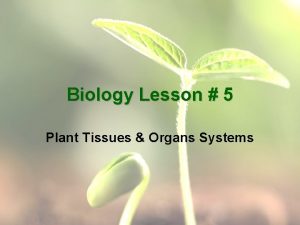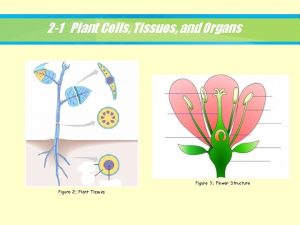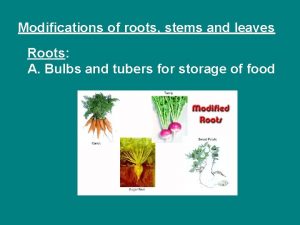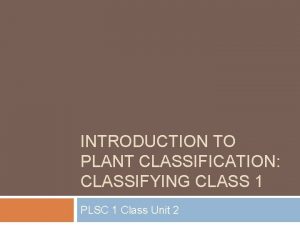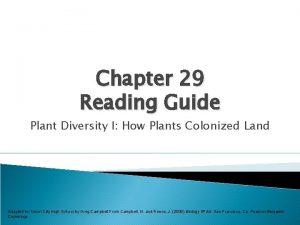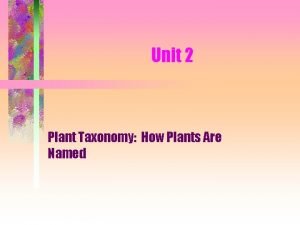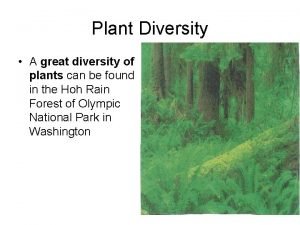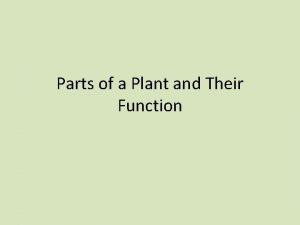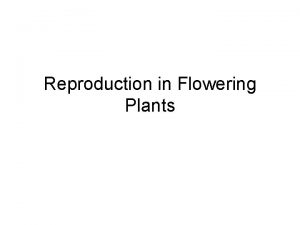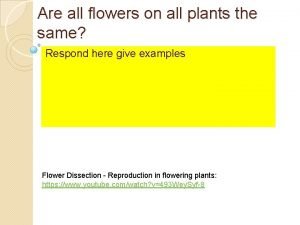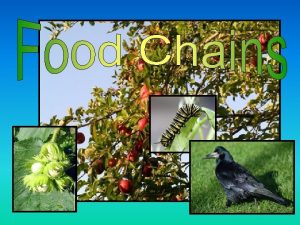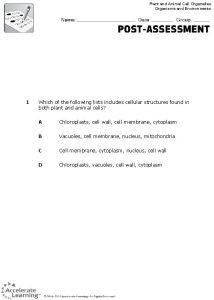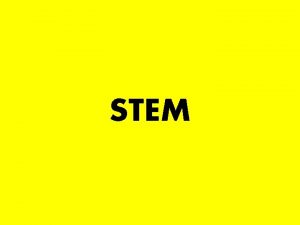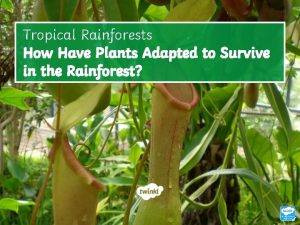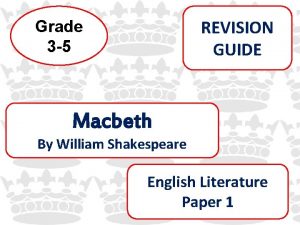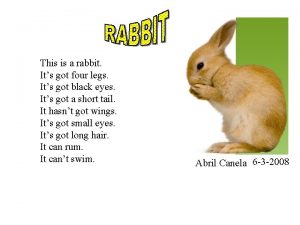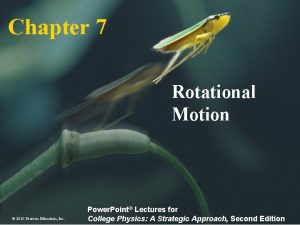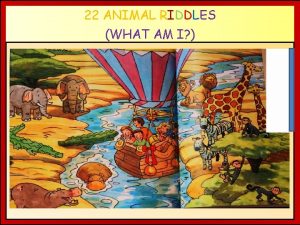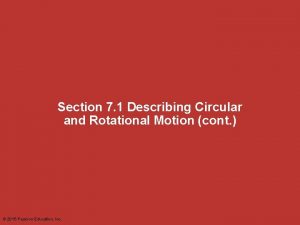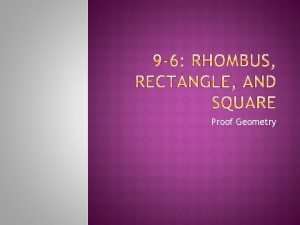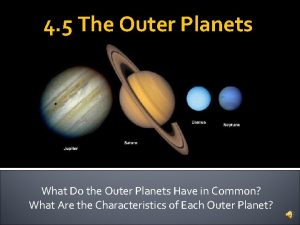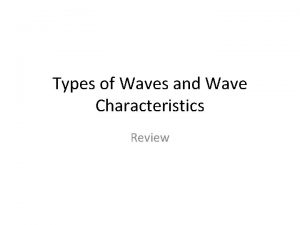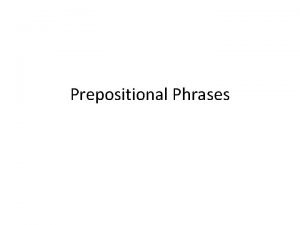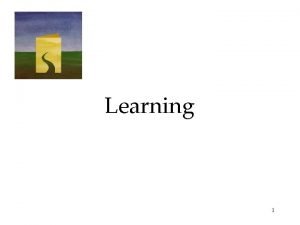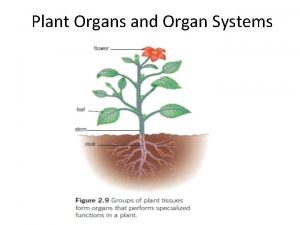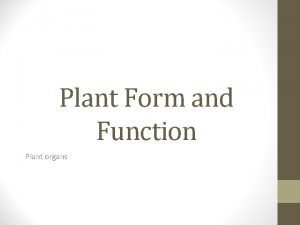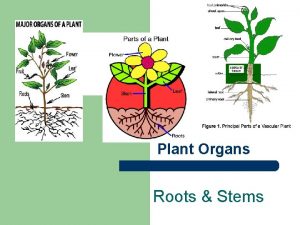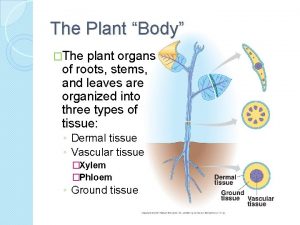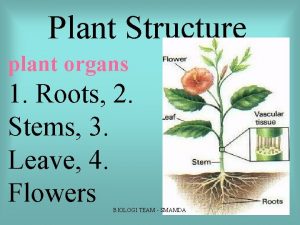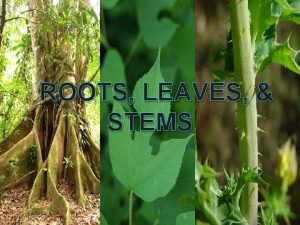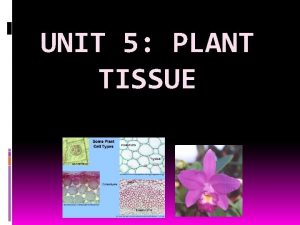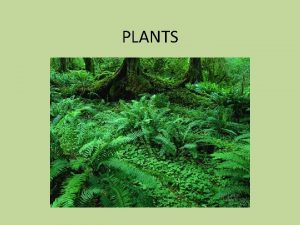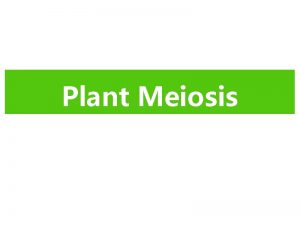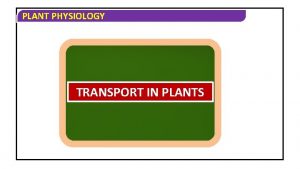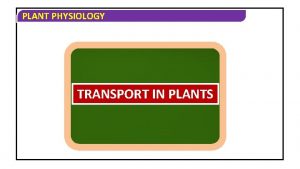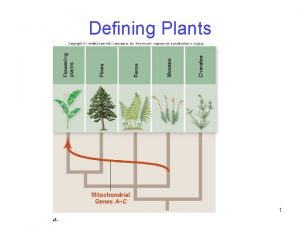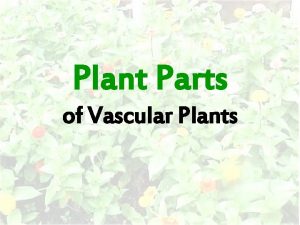PLANT ORGANS Plants generally have four organs Roots








































































- Slides: 72

PLANT ORGANS

Plants generally have four organs: § § Roots Stems Leaves Flowers

ROOTS n Roots hold the plant in place and they absorb water and minerals. Roots usually grow in the direction of gravity (down) which is why they are most often found underground. They have no leaves. In short, the roots are in the ground and they give the plant water to help make its food.

n All roots have a tip. n The growing tip of roots is protected by a root cap consisting of concentric layers of cells surrounding the apical meristem where new root cells are produced.

Root Hairs n Minerals and water molecules enter root hairs and travel through the cells of the cortex by osmosis.

Label the Picture: Root hairs and root cap

Apical meristem: the zone of dividing cells at the root apex which give rise to new cells in a growing root.

n Elongation also occurs within the roots. n What is elongation?

• Label the picture with the following words: elongation and apical meristem.


STEM n Stems are generally above ground, grow upward, and have leaves. n Can stems be different from one another?

Stems of cactus: Give two more examples of stems

Phloem n Some plants have bark which contains phloem. n It is a tissue that conducts synthesized food (glucose) substances (e. g. , from leaves) to parts where needed by transporting the food made in the leaves, down the stems and into the roots. Phloem-FLOWS down the plant!


Xylem n acts as a protective layer on the outside of the plant which helps prevent damage and water loss. It absorbs water and minerals through the roots and transports them up the stem and into the leaves. Xylem transports UP the plant.



Phloem does what? Xylem does what? n n Phloem brings food down the plant. Xylem brings water and minerals up the plant.

n Phloem and Xylem inside of a stem are found inside vascular bundles. n Inside an individual root their inside an endodermis.

n n n n n The table below will help you remember the differences between the two types of vessel: Xylem made of dead cells cell wall thickness thick cell wall material lignin permeability of cell wall impermeable cytoplasm? none Phloem living cells thin cellulose permeable cells lined with cytoplasm strands function transport of water and minerals transport of food carried to. . . leaves growing parts and storage organs direction of flow upward up and down tissue also has. . fibres companion cells


Vascular Cambium n one-cell-thick layer of tissue between xylem and phloem in most vascular plants (plants that contain vessels for transporting) that is responsible for secondary growth. n Produces additional vascular tissues!

Vascular vs. Non-Vascular: tube-like (water, food, etc. ) Ex. Pine, maple, ferns, grass, ivy sunflowers Non-vascular: No tubes (osmosis, diffusion) Ex. Mosses 575 Liverworts 577

Cork Cambium n Located outside the phloem, produces CORK. Cork cells replace the epidermis in woody stems and roots, protecting the plant. Cork cells are DEAD CELLS that provide protection and prevent water loss.



How Old is that tree? n Each year a tree adds a layer of wood to its trunk and branches thus creating the annual rings we see when viewing a section. New wood grows from the cambium layer between the old wood and the bark. In the spring, when moisture is plentiful, the tree devotes its energy to producing new growth cells.

n These first new cells are large, but as the summer progresses their size decreases until, in the fall, growth stops and cells die, with no new growth appearing until the next spring. The contrast between these smaller old cells and next year’s larger new cells is enough to establish a ring, thus making counting possible.


n Wide rings of certain species of trees were produced during wet years and inversely, narrow rings during dry seasons.

n Between you and your lab partner grab a piece of wood and determine the following pieces of data: 1. How old is your tree? 2. How many dry seasons were there? 3. How many wet seasons were there?

The massive trunk of this Chilean wine palm has grown in girth due to the production of new vascular bundles from the primary and secondary thickening meristems.

LEAFS The leaf contains veins and stomatas • Veins: carry nutrients and water through the leaf • Stomatas: are pores in the epidermis of a leaf or stem through which gases and water vapor pass. • Draw a picture of a stomata including their guard cells. Page. 639

Flowers n Are responsible for one important function reproduction. Flowers are the plant’s reproductive structures. Angiosperms are types of plants that bear fruits and flowers. Flowers are usually both male and female, and are brightly colored to attract insects to help them carry pollen used for sexual reproduction.

n Not all flowers are colorful, though. flowers usually use the wind for pollination. These

Complete Flower n In order to be a complete flower you must have all four of the following organs: sepal, petal, stamen, and pistil. n An incomplete flower is missing one or more of the flower organs.

Box Elder Flower!

Flower Anatomy The peduncle is the tip of the stalk where the flower begins. n The receptacle starts at the peduncle and acts as a base to which all other parts of the flower are attached. n Sepals are leaf-like protective coverings of the bud that grow typically in an outer whorl. n Petals are the inner whorl of leaves n

n Pistils are the female organs. There can be one or more. There are 3 parts of the pistil: the stigma receives the pollen and is sticky n the style connects the stigma to the ovary n the ovary is where seeds develop n n Stamen are the male organs. The number of stamen per flower varies. There are 2 parts of the stamen: the filament produces pollen n the anther caps the filament n

Decide what these flowers are from the following choices: n perfect n regular n irregular n incomplete n complete


Investigation of the Leaf Stomata 1. 2. 3. In partners you will be investigating leaf stomata's on plants. They are located on the tops and bottoms of leaves. Each group will need to make an impression on both the top and bottom layers of the leaf. DO NOT TEAR THE LEAF OFF THE PLANT! Be careful!

4. 5. Do not begin the lab until you have read through the lab completely. Then you may begin. Make sure you obtain the proper materials and return them once you have used them.



n Will plants have more stoma open during the day than during the night? n Make a hypothesis about the number of open stomata found in a plant kept in the dark compared to a plant in the light.

1 st hour-in Light Stomatas found on the top 7, 5, 100 ish, 31, 16, 11, 0, 10, 21, 1, 11, Stomatas found on the bottom 7, 100 ish, 36, 5, 10 5 th hour-in dark Stomatas found on the top 0, 0, 30, 6, 8, 4, 80, 6 Stomatas found on the bottom 79, 30, 8, 9, 45 ish, 25, 4, 0

Label the Leaf Diagram

Plant Tissue Systems 3. There are three main types of plant tissues: dermal vascular ground. n The tissues help the plant grow n 1. 2.

DERMAL n The dermal system has the epidermis which is the outermost layer of the plant body. It makes the skin of the plant. Epidermal cells vary in function and structure.

n The epidermis has openings through which gasses are switched with the atmosphere. The openings are enclosed by guard cells which change the size of the stomata openings and control the gas exchange.

It is through the stomata's that gas exchange takes place: photosynthesis and respiration

n The epidermis is covered with a coating called the cuticle, which serves as a waterproof layer and reduces water lost through evaporation. n What are examples of plants with a thick cuticle?

Vascular System n This system is made up of two types of conducting tissues. They are the xylem, which conducts the water, and dissolved mineral nutrients; and the phloem, which conducts food.

Ground System n The ground tissues of plants are made up of three tissues.


Roots n Three main types of roots: 1. Taproot: the first root to develop from a germinating seed, also called primary root, which digs deep into the soil searching for water. Taproots can also act as storage roots, storing water and minerals for the plant


Fibrous Root n Slender, branched roots that look like fine string of yarn.

Adventitious roots n Roots that grow from the stems or leaves of a plant

Contractile roots n Roots that can change in length and thickness, pulling shoots closer to the ground or deeper into the soil.

n The roots grow downward, then contract, pulling the plant's crown (a thick underground stem called a "rhizome") deeper into the mud. Each year, the plant digs itself deeper into the earth and extends its anchor-roots farther down.

Root Hairs n Can be found on any root system. They are tiny projections from the surface cells of a root that extend through the soil around the root.

Draw this picture on the bottom of page 11. Label it Roots. This is a picture looking closely at a root. n Every root has a protective root cap on the end. This allows the new dividing cells a source of protection when the root is digging deep into the n

Draw the following picture (pg. 11)


Vegetable Lab 1. 2. 3. Between you and your lab partner pick 3 vegetables to observe and dissect Fill our the data table regarding your vegetables. Next, dissect only a small portion of the vegetable. Then place your vegetable back for other classes to use.

4. 5. Look at a section of your plant under the microscope and draw a picture of what you see. Answer the questions

MONOCOTS & DICOTS (pg. 8) n Traditionally, the vast world of flowering plants, phylum Anthophyta, has been known as the angiosperms. It has been divided into two great subdivisions, or classes, known as the monocots and the dicots.

Monocots vs. Dicots

Answer these questions on page 11 in your lab book. Read the inside story on page 628 and answer the following questions: 1. What are meristems? 2. What are the different types of meristems?

1. What are meristems? Produce new plant cells. 2. Types of meristems? 1) apical meristem: height 2) vascular cambium: width in stem 3) cork cambium: Bark
 Four organs of a plant
Four organs of a plant Living things that have leaves and roots
Living things that have leaves and roots Vanessa jason biology roots www.biology-roots.com
Vanessa jason biology roots www.biology-roots.com Square root notes
Square root notes Existence and uniqueness of square roots and cube roots
Existence and uniqueness of square roots and cube roots Economic roots of american imperialism
Economic roots of american imperialism Product of roots of quadratic equation
Product of roots of quadratic equation Perfect cube list
Perfect cube list What is a group of organs working together
What is a group of organs working together Why do plants need roots
Why do plants need roots Type of root
Type of root Plant organs
Plant organs Examples of small plants
Examples of small plants Plant organs
Plant organs Daun
Daun Plant tissue and organs
Plant tissue and organs Plant tissue and organs
Plant tissue and organs I have four legs and a tail i have no teeth
I have four legs and a tail i have no teeth Chapter 16 hair cutting
Chapter 16 hair cutting Normal bowel sound
Normal bowel sound Storage stem examples
Storage stem examples Lenticels
Lenticels Nonvascular plants definition
Nonvascular plants definition Nonvascular plant diagram
Nonvascular plant diagram Classification of flowering and non flowering plants
Classification of flowering and non flowering plants C3 plant
C3 plant 8 vertices and 12 edges
8 vertices and 12 edges Gametophytes have gamete-producing organs called _____.
Gametophytes have gamete-producing organs called _____. How plants are named
How plants are named Most conflicts have their roots in
Most conflicts have their roots in Plant evolution cladogram
Plant evolution cladogram Kingdom eukariotik
Kingdom eukariotik Scope of plant breeding
Scope of plant breeding Plant introduction in plant breeding
Plant introduction in plant breeding Plant introduction in plant breeding
Plant introduction in plant breeding Tronsmo plant pathology and plant diseases download
Tronsmo plant pathology and plant diseases download Tronsmo plant pathology and plant diseases download
Tronsmo plant pathology and plant diseases download Tronsmo plant pathology and plant diseases download
Tronsmo plant pathology and plant diseases download 4 parts of plants
4 parts of plants Part of flower that produces pollen
Part of flower that produces pollen Which seedless plants have been used to treat bee stings
Which seedless plants have been used to treat bee stings Do all flowers have male and female parts
Do all flowers have male and female parts Every living plants and animals must have
Every living plants and animals must have Animal cells
Animal cells Herbacious stems
Herbacious stems How have plants adapted to the rainforest
How have plants adapted to the rainforest Plants have different parts
Plants have different parts Why do plants have different parts
Why do plants have different parts Are plants multicellular eukaryotes
Are plants multicellular eukaryotes Why are seedless plants important
Why are seedless plants important Flocabulary photosynthesis read and respond answers
Flocabulary photosynthesis read and respond answers 4 straight sides
4 straight sides 4 eyes in 4 hours
4 eyes in 4 hours I have begun to plant thee
I have begun to plant thee I have got four legs
I have got four legs The four forces shown have the same strength
The four forces shown have the same strength We skated on the frozen lake. this phrase is a(n) _____.
We skated on the frozen lake. this phrase is a(n) _____. Animal riddles
Animal riddles Every open sided floor or platform
Every open sided floor or platform Which third force on the wheel
Which third force on the wheel I have a dream my four little
I have a dream my four little The guy who sits behind marsha likes to play the drums
The guy who sits behind marsha likes to play the drums Every flight of stairs with four or more risers must have
Every flight of stairs with four or more risers must have What are the four outer planets called
What are the four outer planets called Do all quadrilaterals have four sides
Do all quadrilaterals have four sides Def of rectangle
Def of rectangle What do the four outer planets have in common
What do the four outer planets have in common Brainpop weather
Brainpop weather Sound waves from a radio generally travel in which medium?
Sound waves from a radio generally travel in which medium? Whats a prepositional phrase
Whats a prepositional phrase In a minimum cardinality, minimums are generally stated as
In a minimum cardinality, minimums are generally stated as What is relatively permanent
What is relatively permanent Alicia has started a new and very different job
Alicia has started a new and very different job
